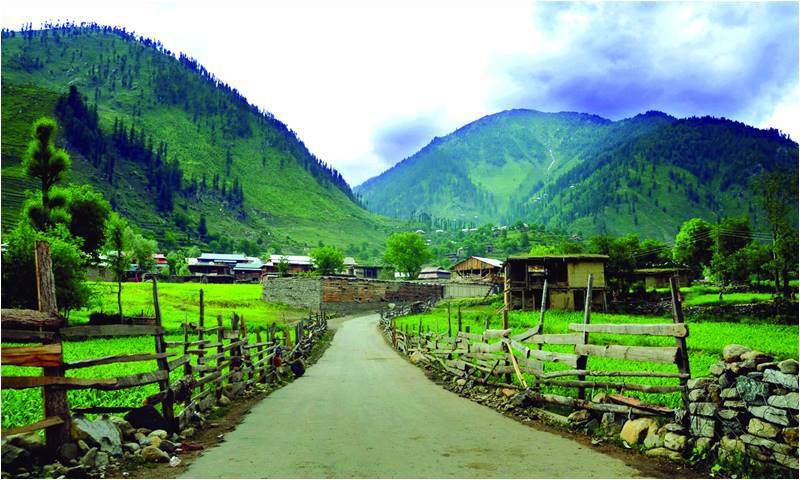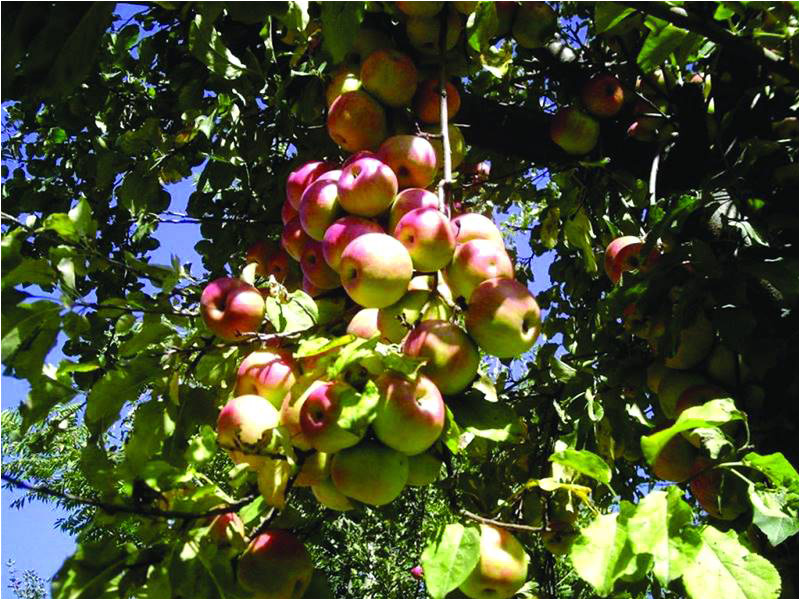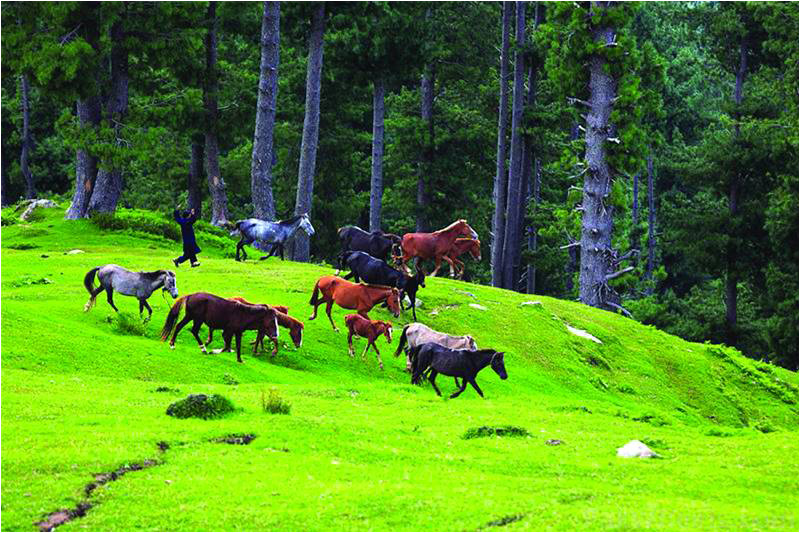
I still remember my prompt reply when someone asked me to recommend a valley in Azad Jammu and Kashmir (AJK) to visit and witness for themselves the spectacular beauty of that land. They were looking for the distinctive Kashmiri style of architecture, the crystal clear and swiftly flowing streams, the rich cuisine; in short containing all essential features associated with the beauty of Kashmir – treasured by the Mughals as Paradise on Earth.
My short answer to them was always “Visit Leepa Valley!”
All those who visited Leepa on my recommendation agree that the valley is a complete package of God-gifted natural beauty as well as the dazzling culture of Kashmir. The visitor is immediately struck by the hospitality of its people. To their delight, the visitor finds high walnut trees all over the valley that add yellow, red and orange colours to the scenery. One cannot help but be enthralled by the sight of yellow shrubs tucked nicely into lush green vegetation comprising of large coniferous trees. All these visual elements bring variety to what can only be described as a miracle of changing colours during autumn in the valley.

But how does one get to Leepa?
When you travel 105 kilometres from Muzaffarabad, the capital city of Azad Kashmir, they arrive in a zone of the most gorgeous, natural and seemingly untouched serenity. The journey is not for the faint of heart, though!
If for the most part of your life you traveled on metaled roads, your greatest preference is to travel on the Motorway your usual idea of a holiday destination is Murree, than perhaps Leepa Valley is not for you. Although it is only 105 kilometers from Muzaffarabad, it could take up to seven hours to reach the Leepa valley. At times you will be traveling at less than 2 km/h. You need to cross Reishan Gali at 3,200 metres above sea level and then you descend to 1,677 meters on the other side of Leepa Valley. Quite understandably, it is jeep track.
The valley is open for tourism from May to November. For the rest of the year, it remains covered in snow. One can take buses or cars up to Reshian. From there on, roughly 38 kilometres must be traveled totally on jeeps.
Mr. Ali Naqvi, my mentor shares his pleasant – or perhaps it would be more accurate to say “freezing”, due to the winter season – memories of Leepa Valley when he, Shah Jahan Balouch and Asif Lehri visited Muzaffarabad during their time at the Institute for Development Studies and Practices (IDSP).

And so Mr. Naqvi tells us:
When I went to Leepa Valley, it was not for touristic reasons. It was in the aftermath of the devastating earthquake of 2005. And yet my experience of the valley was far more profound and enchanting than for many others. People were simple. Women were working in the fields and seemed to have few concerns about talking to strangers. The food was simple, and all organic, by the way. Streams of water were flowing – which you could easily taste.”
The charming Leepa Valley consists of many villages. The most famous among the villages are Leepa, Reshian, Dao Khan and Chananian.
He continues:
“What got our attention at that point in time was the Dargah (shrine) of Mitha Baji Sarkar. The most striking aspect of the Dargah was its location. The Dargah, you see, was split between territories controlled by India and Pakistan. A door used to open in India and another in Pakistan. And so, one could say the Dargah was connecting India and Pakistan. At time of the Urs (festival), the doors would be opened and people from both sides could share in the festivities. The Dargah was managed by an old man. He shared many tales centred around the Dargah and how people are blessed by the intercession of the Pir.”
The houses are Leepa were divided into several floors: the basement for animals so that they keep warm during the chilly weather. The ground floor is used for the animals’ fodder. The family lives on the floor above that. And the topmost floor is used for grain storage. The structure is often entirely made of wood. Such homes are often cozy and beautifully constructed.
The people of Leepa are highly religious and speak Kashmiri as well as Hindko. Urdu is, nevertheless, widely spoken and understood. The valley has a population of about 80,000 inhabitants who generally indulge in farming, cattle-rearing and tourism-related services. Unemployment and poverty are rampant.
A river divides Kashmir between Pakistan and India here: one can clearly see the other side of the border. One can also see how the border communities live, surviving in hostile times – of which the numerous bullet marks on the buildings give ample testimony.
The civilian population settled in the picturesque Leepa valley has often presented a soft target for Indian border forces during times of conflict on the Line of Control. Deaths, injuries and displacement are a routine matter during instances of unprovoked firing from across the Line of Control. The Pakistan Army is deployed at the Leepa sector, guarding this side of the Line.
But Mr. Naqvi’s memories are not just of the conflict that has torn apart Kashmir:
“I remember we had unpolished red rice and chicken curry. I have never had such a delightful combination of rice and curry.”
Maize is an important product of the region. Walnuts, apples, cherries and honey from Leepa are greatly prized.
Finally, the visitor en route to Leepa can see the recently-formed lake which came in to being because of the terrible earthquake of 2005. Two mountains facing each other collided and, unfortunately, compressed the village of Chakkar between them. A local stream was blocked from flowing freely and this resulted in the creation of a lake – on top of the ruins of the village.
Accommodation facilities in the form of a Tourist Rest House and Forest Rest House are available. Owing to the flow of visitors during the summer season, the AJK Tourism Department also provides a tent service for accommodation. So go camping before this summer is over!
Mubashar Naqvi is a freelance writer based in Muzaffarabad. Contct him via Twitter: @SmubasharNaqvi
My short answer to them was always “Visit Leepa Valley!”
All those who visited Leepa on my recommendation agree that the valley is a complete package of God-gifted natural beauty as well as the dazzling culture of Kashmir. The visitor is immediately struck by the hospitality of its people. To their delight, the visitor finds high walnut trees all over the valley that add yellow, red and orange colours to the scenery. One cannot help but be enthralled by the sight of yellow shrubs tucked nicely into lush green vegetation comprising of large coniferous trees. All these visual elements bring variety to what can only be described as a miracle of changing colours during autumn in the valley.

But how does one get to Leepa?
When you travel 105 kilometres from Muzaffarabad, the capital city of Azad Kashmir, they arrive in a zone of the most gorgeous, natural and seemingly untouched serenity. The journey is not for the faint of heart, though!
If for the most part of your life you traveled on metaled roads, your greatest preference is to travel on the Motorway your usual idea of a holiday destination is Murree, than perhaps Leepa Valley is not for you. Although it is only 105 kilometers from Muzaffarabad, it could take up to seven hours to reach the Leepa valley. At times you will be traveling at less than 2 km/h. You need to cross Reishan Gali at 3,200 metres above sea level and then you descend to 1,677 meters on the other side of Leepa Valley. Quite understandably, it is jeep track.
The valley is open for tourism from May to November. For the rest of the year, it remains covered in snow. One can take buses or cars up to Reshian. From there on, roughly 38 kilometres must be traveled totally on jeeps.
Mr. Ali Naqvi, my mentor shares his pleasant – or perhaps it would be more accurate to say “freezing”, due to the winter season – memories of Leepa Valley when he, Shah Jahan Balouch and Asif Lehri visited Muzaffarabad during their time at the Institute for Development Studies and Practices (IDSP).

And so Mr. Naqvi tells us:
When I went to Leepa Valley, it was not for touristic reasons. It was in the aftermath of the devastating earthquake of 2005. And yet my experience of the valley was far more profound and enchanting than for many others. People were simple. Women were working in the fields and seemed to have few concerns about talking to strangers. The food was simple, and all organic, by the way. Streams of water were flowing – which you could easily taste.”
The charming Leepa Valley consists of many villages. The most famous among the villages are Leepa, Reshian, Dao Khan and Chananian.
He continues:
“What got our attention at that point in time was the Dargah (shrine) of Mitha Baji Sarkar. The most striking aspect of the Dargah was its location. The Dargah, you see, was split between territories controlled by India and Pakistan. A door used to open in India and another in Pakistan. And so, one could say the Dargah was connecting India and Pakistan. At time of the Urs (festival), the doors would be opened and people from both sides could share in the festivities. The Dargah was managed by an old man. He shared many tales centred around the Dargah and how people are blessed by the intercession of the Pir.”
The houses are Leepa were divided into several floors: the basement for animals so that they keep warm during the chilly weather. The ground floor is used for the animals’ fodder. The family lives on the floor above that. And the topmost floor is used for grain storage. The structure is often entirely made of wood. Such homes are often cozy and beautifully constructed.
The people of Leepa are highly religious and speak Kashmiri as well as Hindko. Urdu is, nevertheless, widely spoken and understood. The valley has a population of about 80,000 inhabitants who generally indulge in farming, cattle-rearing and tourism-related services. Unemployment and poverty are rampant.
A river divides Kashmir between Pakistan and India here: one can clearly see the other side of the border. One can also see how the border communities live, surviving in hostile times – of which the numerous bullet marks on the buildings give ample testimony.
The civilian population settled in the picturesque Leepa valley has often presented a soft target for Indian border forces during times of conflict on the Line of Control. Deaths, injuries and displacement are a routine matter during instances of unprovoked firing from across the Line of Control. The Pakistan Army is deployed at the Leepa sector, guarding this side of the Line.
But Mr. Naqvi’s memories are not just of the conflict that has torn apart Kashmir:
“I remember we had unpolished red rice and chicken curry. I have never had such a delightful combination of rice and curry.”
Maize is an important product of the region. Walnuts, apples, cherries and honey from Leepa are greatly prized.
Finally, the visitor en route to Leepa can see the recently-formed lake which came in to being because of the terrible earthquake of 2005. Two mountains facing each other collided and, unfortunately, compressed the village of Chakkar between them. A local stream was blocked from flowing freely and this resulted in the creation of a lake – on top of the ruins of the village.
Accommodation facilities in the form of a Tourist Rest House and Forest Rest House are available. Owing to the flow of visitors during the summer season, the AJK Tourism Department also provides a tent service for accommodation. So go camping before this summer is over!
Mubashar Naqvi is a freelance writer based in Muzaffarabad. Contct him via Twitter: @SmubasharNaqvi

